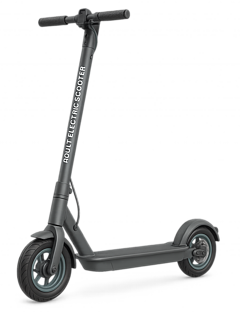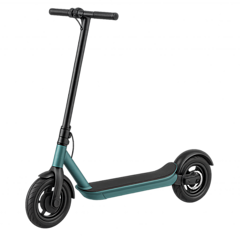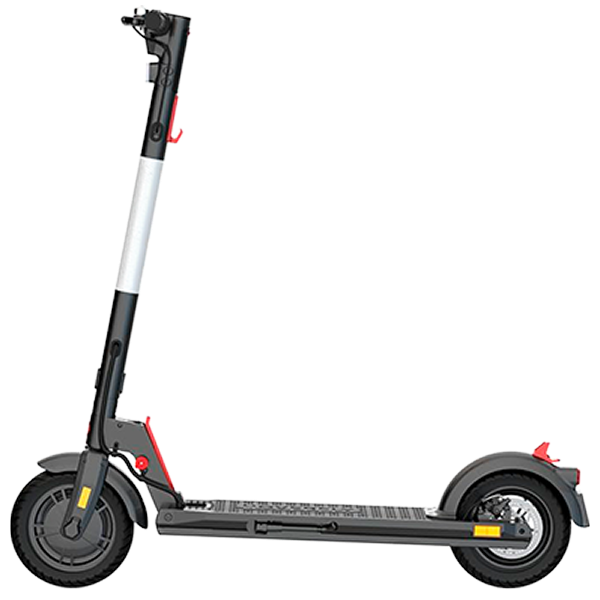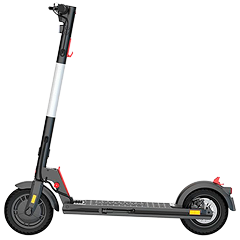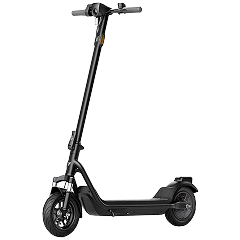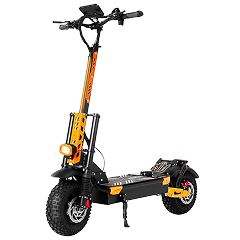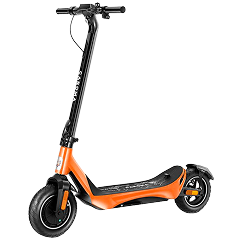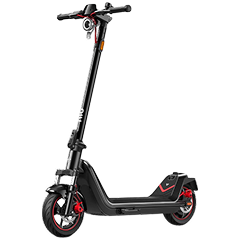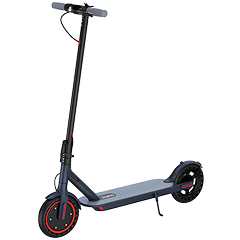In this guide, we’ll break down what counts as “long-range,” help you figure out if you need one, and show you what to look for when shopping.
What is a Long-Range Electric Scooter?
“Long-range” isn’t an official category, but generally it means a scooter that can travel at least around 25–30 miles on a single charge.
Considering most budget and commuter scooters only get 10–20 miles, anything above 30 miles per charge is usually considered long-range. These scooters pack larger batteries and often fall into higher performance categories.
To put things in perspective, we can group scooter ranges into a few tiers:
- Low-Range Scooters: Typically have under 400 Wh batteries and about 10–18 miles of real-world range per charge. These are basic commuters or budget models that are fine for short trips.
- Moderate-Range Scooters: Usually 500–900 Wh batteries, delivering roughly 18–25 miles of range. A big chunk of popular mid-tier scooters fall here, enough for medium commutes or longer recreational rides.
- Long-Range Scooters: These feature 900-1,500Wh battery capacity and often deliver 25-35+ miles of tested range. This is where high-performance models start to shine, offering enough battery power (and usually higher cost) to comfortably exceed typical commute distances.
- Ultra Long-Range Scooters: The top tier, with 1,500+ Wh batteries (some even above 2,500Wh). These scooters can exceed 40–60 miles of real-world range. Some record-setters have hit 60–70+ miles on a single charge in controlled tests. At that point, you’ll probably get tired before the battery does.
Key Factors When Choosing a Long-Range Electric Scooter
Once you’ve decided that you do want that extra range, it’s important to know what features and specs matter most. Here are the essential factors and how to evaluate them:
Match the Scooter to Your Commute
Before you mortgage your house for a 70-pound scooter, do some math. What’s your actual daily distance? If your daily commute or regular route is, say, 5–10 miles round trip, a standard scooter might suffice. On the other hand, if you have a lengthy commute, no convenient charging opportunities, or love taking extended rides, a long-range scooter can save you a ton of hassle.
Range anxiety (the fear your battery will die before you reach your destination) is the worst. So you’ll want a scooter that can comfortably cover your full round-trip distance with a bit of cushion. A good rule of thumb is to have about 1.5× the range of your typical trip. For example, if you commute 15 miles total per day, look for 22+ miles tested range.
Range: Tested vs. Claimed Mileage
Every scooter will have two range numbers: the manufacturer’s claimed range (often measured under ideal conditions) and the tested range (real-world result, usually at faster speeds with a rider of average weight). The tested range is typically much lower than the marketing numbers.
For instance, a popular model like the Segway Ninebot Max is advertised at 40 miles, but in reality gets closer to 28 miles in rigorous tests. This discrepancy comes from manufacturers testing at slow speeds, with light riders, on perfect flat terrain, etc., whereas your actual ride involves hills, stops, and full throttle bursts.
Always prioritize the tested range if available, or at least take claims with a large grain of salt. If you don’t have exact data, take the advertised range and multiply by 0.6 for a safe estimate of actual range. This buffer accounts for factors like hills, speed, and battery degradation. So if a scooter is advertised for 40 miles, expect around 24 miles under normal conditions.
To illustrate the gap between battery specs, real range, and claims, check out the table below using data from real-world scooter tests:
Larger batteries generally yield more miles in practice, while manufacturer claims (right column) are often much higher than tested results. Below 360 Wh, the gap shrinks as compact commuters don’t leave as much room for marketing optimism. Once capacity tops 360 Wh, brands usually quote ranges about 20–40 % higher than road tests. A scooter with a 2,500 Wh pack covers roughly 55 miles in real rides, while some spec sheets promise 90–100 miles.
The Battery (Capacity, Type, and Brand)
The battery is the single most important component that dictates a scooter’s range. When comparing long-range models, pay close attention to the battery specs:
Battery Capacity (Wh)
Battery capacity is a more reliable predictor of range than manufacturer mileage claims, which, as we discussed, can be pretty inflated.
Capacity, measured in watt-hours (Wh), directly correlates with range. Basically, the higher the Wh, the further you can go. For instance, a 500 Wh pack covers around 16 – 18 miles. Move to 1,000 Wh and you reach roughly 25 – 30 miles. That’s about 2 miles for every extra 100 Wh.
Most entry-level scooters have under 300 Wh and tend to peter out before 15 miles. Long-range models often pack 1000 Wh+.
Naturally, more capacity also adds cost and weight. There’s also diminishing returns – doubling battery size doesn’t always double the range if you ride faster or have other performance upgrades. But broadly, if everything else is equal, a scooter with a 1000 Wh battery will go roughly two-thirds as far as one with a 500 Wh battery.
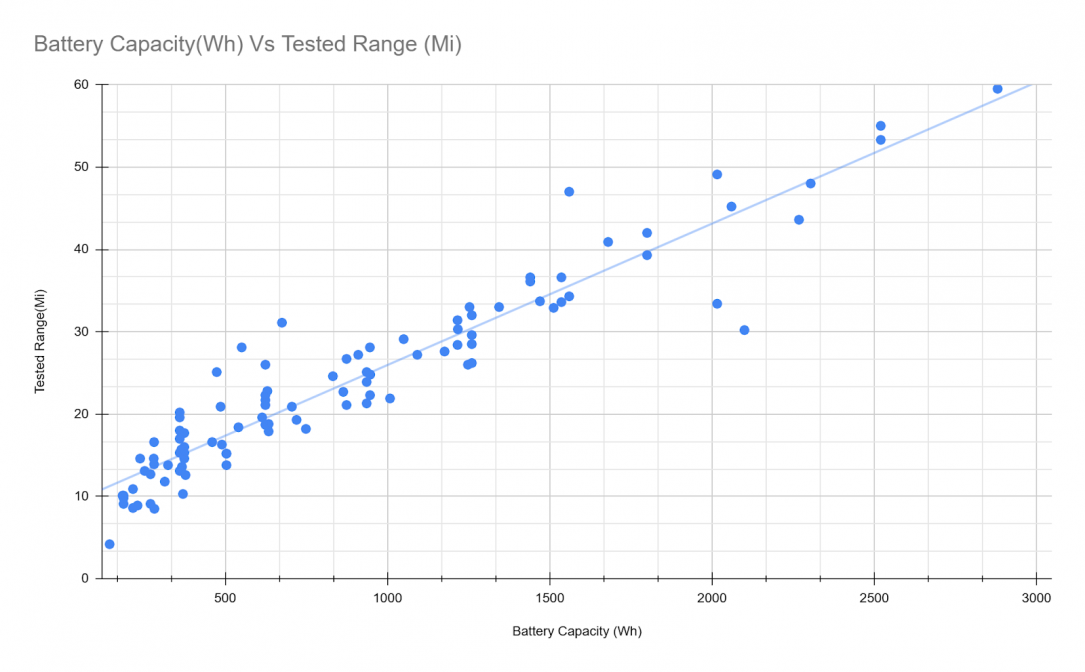
Figure: Battery capacity vs. tested range for a variety of electric scooters. Each blue dot represents the tested range of specific scooter models. As the battery (Wh) increases, the achievable range rises nearly linearly, but note that doubling the battery doesn’t always double the range due to other limiting factors. Still, more Wh generally means more miles.
Battery Brand/Quality
Choosing a scooter with quality battery cells and a good Battery Management System (BMS) means more reliable performance, better safety, and typically a longer life cycle. Generic or no-name batteries might be cheaper, but they could have inconsistent performance and might not last as long.
Given that the battery is the most expensive part of an e-scooter (and the part that can potentially catch fire if something goes wrong), you’ll want the peace of mind of a well-made pack.
When possible, check the specs for the battery brand. For example, a scooter advertising an “LG 21700 50E battery pack” is a good sign that it’s using high-quality cells. In contrast, if the spec sheet doesn’t mention the battery brand at all, assume it’s a generic pack. That’s not a deal-breaker, but know that you may not get the same longevity.
Also, check if the manufacturer offers a warranty on the battery (at least 6–12 months is common). Replacing a big battery can be costly (often $150–$500 or more, depending on size) – for instance, a 36V (280 Wh) Xiaomi pack costs about $180, while a larger 48V pack can run $480.
Battery Type (Lithium vs. Lead Acid)
Lithium batteries offer far greater energy density (more energy in a lighter package) and a longer lifespan than old-school lead-acid batteries. If you somehow encounter a scooter using lead-acid (mostly in some cheap or older models), be aware that it will be much heavier and deliver a shorter range for the same physical size. In short, lithium-ion is the way to go for any long-range e-scooter. Thankfully, most manufacturers have moved to lithium by default.
Charging Time
More range means a bigger battery, and that means more charging time. It’s not the most exciting spec, but it’s important to consider how you’ll keep that battery charged.
Your average commuter scooter takes 4-6 hours to juice up, which is reasonable. But long-range models? We’re talking 6 hours minimum, up to 15+ hours if you’re using the included standard charger. For example, an average 1000 Wh battery with a 2A charger (standard default) will take around 7–8 hours to fully charge. Double the battery (2000 Wh) and you could be looking at 14–16 hours overnight.
If charging time sounds like an issue, look for scooters that support fast charging or dual chargers. Many performance scooters have the option to plug in two chargers at once or use a high-speed charger (like 4A or 5A, often sold separately) to cut the charging time in half. The catch is that fast chargers usually cost extra, and using them too often can slightly accelerate battery wear. It’s a balance, occasional fast charging won’t hurt, but I wouldn’t fast-charge every single day if not needed.
Also, consider if the scooter has a removable battery. Some models let you detach the battery pack, where you could keep a spare charged battery to swap in for extended rides, or charge the battery separately from the scooter. Removable batteries are more common in mid-range scooters, but a few long-range models have them.
Comfort and Ride Quality
Long-range trips mean you’ll spend a lot of time on the scooter and the last thing you want is numb hands or a sore back from a bumpy, uncomfortable ride.
When evaluating a scooter, pay attention to features that enhance ride quality:
Suspension
Most long-range scooters ship with spring or hydraulic suspension. For the best feel, pick a model with dual suspension (front and rear). Even a basic suspension system will greatly improve comfort on longer rides.
Tires
Pneumatic air-filled tires are non-negotiable for long-range riding. Air tires provide the cushioning and traction that solid tires simply can’t match, and anyone who’s ridden both will tell you the difference is night and day.
To get some of the maintenance benefits of solid tires while keeping the performance advantages, go tubeless. Tubeless pneumatic tires are relatively easy to fix when you inevitably pick up a puncture, and you can often repair them without even removing the wheel.
Take it a step further and look for tubeless tires that come with sealant already installed. The liquid sealant automatically plugs small punctures from nails, screws, and everyday road debris. If your tires don’t come with sealant, you can simply add some yourself.
When it comes to tire size, bigger is genuinely better. Go for 10 inches or larger in diameter, and look for a reasonable width of around 3 inches or more. Larger wheels roll over bumps and road imperfections more easily, which translates directly to better comfort and stability at speed.
Deck and Riding stance
Check that the deck is spacious enough for you to stand comfortably, possibly with both feet side by side, or at least staggered, without feeling cramped. A deck around 18–20+ inches long and adequately wide will let you shift foot positions occasionally, which is important to avoid fatigue. You also need a deck that is grippy enough to keep you planted when riding, as constantly shifting your footing because your feet keep sliding around gets tiring fast.
Handlebar Height & Ergonomics
Handlebars should sit roughly at waist or mid-torso level for most adults. Too low and you’ll develop a permanent hunch. Too high becomes unwieldy and tiring. Also consider handlebar width; wider bars provide more stable control, which is particularly helpful at higher speeds and reduces wobble.
Extra Features for Long Rides
Some long-range scooters offer optional seat attachments, which can provide welcome relief for your legs on marathon rides. Cruise control is another blessing for long, straight stretches. It lets you relax your throttle hand periodically, which might not seem important until mile 25 when your grip is cramping. You won’t use cruise control in stop-and-go city traffic, but on open paths it’s genuinely helpful.
Motor Power and Speed
When you’re covering a lot of ground, you also want enough motor power to handle various terrains and to maintain a decent speed.
For a satisfying long-range ride, look for at least a 500W nominal motor (or dual motors that add up similarly). This ensures the scooter can tackle hills and maintain decent speeds without straining. If you’re a heavier rider (let’s say over 220 lbs / 100 kg), you might want 800–1000W+ of nominal power or a dual-motor setup.
Top speed matters too, but not for the reasons you might think. While you don’t necessarily need a 50 mph monster, a scooter with only a 10 mph top speed will make a 30-mile trip feel endless. For long commutes, a top speed around 20 mph or higher strikes a good balance. Around 20–30 mph is plenty fast for most, allowing you to cover distance in a reasonable time.
Plus, riding near top speed tends to drain the battery faster, so you might actually get better range on a scooter that can go 25+ mph but that you cruise at 15–20 mph, versus a scooter that maxes out at 15 mph (which would likely need full throttle the whole way).
Weight Capacity and Durability
Every scooter has a recommended maximum rider weight. If you’re going long distances, it’s critical to ensure the scooter can comfortably support you (and maybe a backpack or gear).
Most standard scooters max out around 220 lbs or 100 kg. Push beyond this limit and you’ll see dramatic reductions in range and performance. The motor works harder, the battery drains faster, and everything operates at the edge of its capability.
If you’re near or above the standard 220 lb limit, look for a model with a higher weight capacity (some long-range and heavy-duty models support 265 lbs, 300 lbs, or more). Riding within the scooter’s limits means it won’t be straining at the edge of its capability the whole time, which is not only better for range but also for the longevity of the motor and battery.
Besides range reduction, riding a scooter not built for your weight can be unsafe. It can affect braking distance, tire pressure (more weight = higher chance of flats if tires are under-inflated), and even cause frame or stem issues over time.
One more “weight” to consider is the weight of the scooter itself. Long-range models are heavy and there’s no way around it. It’s common for them to weigh 50, 70, or even 100 pounds for the extreme ones. This affects portability. If you need to carry the scooter upstairs or lift it into a car regularly, think hard about what weight you can manage.
You might love the 60-mile range, but a 100-pound scooter is basically a motorcycle to lug around. There are a few long-range designs that keep weight reasonable, but generally, more range = more weight. Make sure you have a plan for storing and handling it.
Warranty and Support
The longer and more comprehensive, the better. Ideally, you want at least a 1-year warranty that covers the battery, motor, and other critical parts.
Consider the brand’s customer service reputation too. Long-range scooters sometimes need maintenance, and you want confidence that you can get spare parts like brake pads and tires, plus knowledgeable support when problems arise. Do some research on the company’s support history before committing.
Factors Affecting Real-World Range
Real-world range can vary because of several factors. You might get more or less miles than someone else on the same scooter, depending on how and where you ride. Here are the main factors that impact your actual range:
Rider Weight
The heavier the rider and any cargo, the more energy needed to move the scooter, which drains the battery faster. A lighter rider will squeeze out more miles than a heavier rider on the same machine. Manufacturers often base their range claims on a 165 lb rider, so if you weigh more, expect your numbers to come in lower.
Terrain
Riding up steep inclines or tackling uneven terrain like off-road trails or grass draws more power compared to smooth, flat pavement. Your motor has to work much harder fighting gravity and rolling resistance, which shows up immediately in your battery meter.
Riding Style
Aggressive riding with rapid acceleration from stops, frequent hard braking, and constant top-speed runs will consume energy quickly and slash your range. Riding more relaxed, accelerating gradually, and maintaining moderate speeds can significantly extend your distance per charge. Most scooters offer riding modes like eco, normal, and sport. Using eco or medium mode for daily travel can help you go much farther on each charge.
Motor Power and Number of Motors
High-performance scooters with powerful dual motors are super fun and necessary for high speed or steep hills, but know that more powerful motors can draw more power from the battery, especially if you push them to their limits. If you’re riding a dual-motor scooter in its highest setting, you’ll likely see less range than in single-motor or eco mode.
Weather and Temperature
Cold temperatures significantly impact battery performance. Chemical reactions inside the cells slow down below about 10°C, causing internal resistance to rise and voltage to sag sooner under load. The controller cuts power earlier than normal. Both lab tests and real-world reports consistently show 30 to 50% range loss once temperatures drop to 0°C. Though honestly, if you’re riding in freezing weather, range might not be your biggest concern.
Charging a battery below freezing can also cause metallic lithium to plate onto the anode, permanently reducing capacity while increasing fire risk. Most smart chargers won’t even start in freezing conditions.
Hot temperatures can significantly damage battery performance and long-term health, especially when riding under scorching sun or leaving the scooter in a hot car. Once deck temperature climbs past about 35°C, the battery management system begins limiting current to prevent the pack from crossing its safety ceiling near 55°C. You’ll experience this protection as softer acceleration or sudden power cuts on hills. When ambient air exceeds 40°C, range can drop by 10 to 15% as the controller caps output to keep the pack cool.
The long-term effects are even more concerning. Storage data show that a pack kept at 40°C and 100% charge degrades to roughly 65% of its original capacity within just one year. Bump the temperature to 60°C and this same loss accelerates to about three months. Even when stored at half charge, a year at 40°C still erases around 15% of capacity.
Charging in hot conditions poses additional risks. Standard cells should only be charged when pack temperature stays below 45°C, and many brands incorporate automatic shut offs that disable charging once the deck gets too hot.
Why a Long-Range Electric Scooter Might Not Be for You
Long-range scooters are awesome for certain riders, but they aren’t the perfect choice for everyone. Here are a few reasons a super high-range scooter might not fit your needs:
Heavy and Less Portable
As mentioned, the bigger battery and sturdier build make these scooters heavy. If you have to frequently lift or fold the scooter (into a car trunk, up stairs, on public transit), a long-range model could be a pain. A lighter, shorter-range scooter is much easier to carry around the city.
Higher Cost
More battery capacity and bigger components mean a higher price tag. Long-range e-scooters are generally more expensive than their low-range counterparts. You’re essentially paying for more battery cells and often stronger motors/frames. If your rides are usually short, you could save a lot of money by choosing a mid-range scooter that already covers your distance.
Longer Charging Times
We touched on this earlier, if you’re not using fast chargers, that big battery can take half a day to charge. If you’re an impatient type or need to charge multiple times in a day, a long-range scooter might be inconvenient. If you forget to charge a long-range scooter overnight, you might be stuck waiting in the morning.
Diminishing Returns for Casual Use
If you ride just a few miles a day, a long-range scooter is overkill. The battery might only need charging once a week, but you’re lugging all that unused capacity around all the time. Meanwhile, battery cells age over time even when not heavily used, so after a few years, even a rarely-used long-range battery will hold less charge. In other words, if you’re not utilizing it, you’re not really preserving it indefinitely.
FAQs
Which Electric Scooter has the Longest Range
For something more mainstream, models like the EMOVE Cruiser (30-50 miles real range based on the model) or NAMI Klima (40+ miles) are often lauded for their long range at a relatively “affordable price”. The landscape constantly changes, but the longest-range crown tends to belong to scooters with 60 to 72V high-capacity battery systems packing 2,000+ Wh.
How Can I Increase the Range of My Electric Scooter
There are a few tricks to squeeze out more miles:
- Ride in eco mode or lower speed settings. Slowing down just a bit dramatically preserves battery life.
- Avoid rapid starts and stops. Rapid throttle punches send a surge of current through the controller and battery. High current means high power losses because the heat generated in cables, cells, and windings rises. More heat equals energy that never reaches the wheel. A hard launch also spins the motor outside its most efficient zone, so you burn watt-hours fast for only a short gain in speed. Smooth riding solves both problems. A gentle roll-on keeps current draw low, the motor stays in its sweet spot, and internal resistance waste drops sharply.
- Keep your tires properly inflated if you have pneumatic tires, and consider slightly higher pressure within the recommended range for lower rolling resistance. Under-inflated tires create drag, which directly reduces range.
- Also, ride in milder temperatures. Batteries yield more range in moderate weather than in extreme cold or heat.
- Lastly, keep your scooter well maintained too. A dirty or dragging brake, motor friction, or corroded bearings can reduce efficiency. Make sure the wheels spin freely, and nothing is causing extra resistance. Lubricate moving parts as recommended and ensure brakes aren’t rubbing when released.
Can You Overcharge an Electric Scooter
However, leaving a scooter plugged in for days on end once it’s full isn’t recommended. Keeping a lithium-ion battery at 100% for extended periods can degrade the battery over time. The best practice is to unplug the charger after the scooter reaches 80 to 90% and save 100% for when you need maximum range.
How Long Do Electric Scooter Batteries Last
Lithium-ion batteries commonly last around 300 to 500 full cycles before their capacity drops significantly. After 500 charges, you might only get 70 to 80% of the range you got when new. In real-world terms, if you use your scooter daily and charge several times a week, the battery could last 2 to 3 years before you notice a big drop in performance. With lighter use, you might get 4 to 5 years. In terms of miles, a scooter with an average 10-mile range translates to about 3,000 to 5,000 total miles over the battery’s life.
How Often Should I Charge My Electric Scooter
How Much Does an Electric Scooter Battery Cost to Replace
If you’re handy with electronics, individual cells can be replaced or a battery pack can be rebuilt, but for most users it’s easier and safer to buy a complete replacement pack made for your model.
When Should a Scooter Battery Be Replaced
Another sign is if the battery meter fluctuates wildly or the scooter cuts out under load. This could indicate the battery can’t hold voltage well under strain, which becomes a safety issue.
In terms of time, this often happens around the 2 to 3-year mark with daily usage. Some riders stretch to 4+ years if the range is still acceptable for their needs. There’s no hard expiration date. If you’re okay with a shorter range, you can keep using the old battery. However, if the battery has bloated or shows physical damage, that’s an immediate sign to stop using it for safety reasons.
Which Battery Is Best for an Electric Scooter
The specific format matters less than the quality of the cells and pack design. The best battery would use high-quality 18650 or 21700 cells from brands like LG, Samsung, Panasonic, or Sony, paired with a well-engineered BMS. These reputable brands have proven longevity and safety records.
Battery voltage is another consideration. Higher voltage like 48V, 52V, 60V, or 72V, doesn’t directly equal more range; that’s determined by Wh capacity, but it can allow the motor to run more efficiently and with more power. Many long-range scooters are 52V or higher, which is part of why they can maintain performance as the battery drains. A 52V or 60V system with quality cells could be considered better in performance than a 36V system, though again, capacity in Wh determines actual range.
So if the question is lead-acid versus lithium, choose lithium every time. If it’s about specific lithium brands, look for known brand cells and a good Battery Management System.


